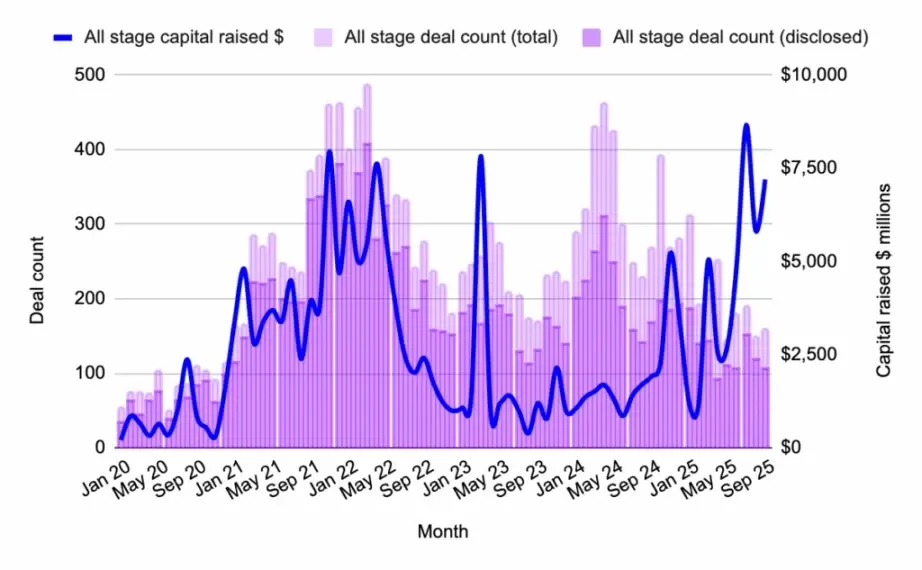The supply of stablecoins on the Ethereum network has reached a historic record of $184.1 billion, injecting strong momentum into the crypto market. According to the latest chart data from Token Terminal, as of October 30, 2025, the supply of stablecoins on the Ethereum network has reached approximately $184.1 billion, marking an all-time high.
This milestone not only reflects strong confidence from capital in the Ethereum network but also suggests that the cryptocurrency market may be brewing a new wave of upward momentum.

1. Milestone in Stablecoin Growth
According to the latest chart data from Token Terminal, the supply of stablecoins on the Ethereum network has reached approximately $184.1 billion, a figure that sets a historical record and highlights the core position of stablecoins within the Ethereum ecosystem.
● This milestone growth is not coincidental; it is a direct reflection of Ethereum's continuous maturation as a decentralized financial infrastructure. The surge in stablecoin supply provides a deeper liquidity foundation for the entire crypto market while also bringing sustained value support to the Ethereum network.
2. Multi-Dimensional Analysis of Stablecoin Growth Effects
Liquidity Cornerstone: Injecting Strong Momentum into the Crypto Market
● The surge in stablecoin supply provides strong potential purchasing power for the cryptocurrency market. This vast liquidity reservoir can quickly convert into buying power for Bitcoin, Ethereum, and other crypto assets when clear investment opportunities arise, becoming a strong driving force for market uptrends.
● A large amount of stablecoins is stored in Ethereum wallets, indicating that investors are in a wait-and-see mode. Once market sentiment turns positive, these funds may quickly flow into the trading market. This mechanism provides a natural buffer for the crypto market and creates potential upward momentum.
● Meanwhile, the annual stablecoin transfer volume has surpassed $50 trillion, with Ethereum leading all blockchains with a transfer volume of $16.7 trillion, demonstrating the increasingly important mediating role of stablecoins in the crypto economy.
Ecosystem Prosperity: Consolidating Ethereum's Dominance
● Stablecoins have become the lifeblood of the Ethereum ecosystem, with Tether's USDT alone accounting for $181.4 billion in supply and 60% of the market share.
● The total value locked (TVL) in Ethereum's DeFi sector surged from $83.2 billion in July 2024 to $114.9 billion in September 2025, with liquid staking and re-staking protocols accounting for as much as 45%. The correlation between stablecoin growth and DeFi applications is undeniable, as they together form the core pillars of Ethereum network value.
● According to AiCoin data, the current total locked value in DeFi applications is $15.1 billion, with nearly two-thirds (approximately $8.6 billion) on Ethereum. Ethereum also holds a 54% share of the stablecoin market.
Institutional Entry: Traditional Finance Embraces On-Chain Finance
● In 2025, institutional adoption is advancing at a faster pace, with Ethereum even surpassing Bitcoin for the first time in third-quarter capital inflows. AiCoin data shows that institutional inflows into Ethereum reached $9.6 billion, compared to $8.7 billion for Bitcoin.
● The approval of spot Ethereum ETFs further legitimizes this asset class, with U.S. funds managing $25.81 billion in assets through tools like BlackRock's iShares Ethereum Trust, accounting for 5.66% of the total ETH supply.
● This influx of capital is reshaping Ethereum's economic model. Currently, 14 publicly listed companies hold a total of 4.36 million ETH (worth $2.07 billion). Innovations like ERC-3643 (a permissioned token standard for real-world asset tokenization) have attracted the attention of large institutions, including BlackRock.
3. Major Stablecoin Market Shares and Characteristics
The table below lists the supply data and market positions of major stablecoins on the Ethereum network:
| Stablecoin | Market Share | Key Features and Use Cases | |------------|--------------|-----------------------------| | USDT | Approximately 60% | Dominates on-chain trading and cross-border settlements, strongest liquidity | | USDC | Not explicitly listed | Favored by institutions for compliance and transparency, 1:1 USD reserve monthly attestation | | Emerging Stablecoins | Gradual growth | Yield-bearing products like syrupUSDC, syrupUSDT, integrated into lending protocols |
Source: Compiled by AiCoin
4. Comparison of Stablecoin Activities Across Public Chains
The table below compares the activities of major public chains in the stablecoin sector:
| Public Chain | Annual Stablecoin Transfer Volume | Market Position and Characteristics | |------------------|--------------------------------------|----------------------------------------| | Ethereum | $16.7 trillion | Dominant platform for stablecoin issuance, holds 54% market share | | Base | $14.7 trillion | Second in transfer volume, rapidly growing | | TRON | $7.6 trillion | Popular in payment sector, holds $81 billion in stablecoins | | Solana | $7.1 trillion | Attracts users with high speed and low transaction fees |
Source: Compiled by AiCoin
5. Exploring the Forces Behind Stablecoin Growth
Regulatory Clarity and Institutional Adoption
● The explosion of the stablecoin market in 2025 is not coincidental; one of its main driving forces comes from the improved regulatory environment. The U.S. passed the GENIUS Act in July 2025, establishing a regulatory framework for stablecoins.
This legislation provides a clear compliance path for stablecoin issuers, encouraging more traditional financial institutions to participate in the market. Since the passage of this act, the stablecoin market has grown from $205 billion at the beginning of 2025 to its current $308 billion.
● Meanwhile, the value of real-world asset tokenization has increased from $16 billion to $34 billion, indicating that traditional assets are accelerating their transition to on-chain.
Traditional financial giants like JPMorgan and PayPal have launched their own stablecoin projects, and both have chosen Ethereum as their issuance platform.
Technological Upgrades and Ecosystem Innovation
● Ethereum's technological upgrades have also provided a solid foundation for stablecoin growth. EIP-4844 and the Dencun upgrade significantly enhance the network's scalability, creating conditions for the large-scale application of stablecoins.
● At the same time, collaborations like those between RedStone and Kalshi provide prediction market data regulated by the U.S. Commodity Futures Trading Commission to DeFi protocols, further blurring the lines between traditional finance and decentralized finance.
● The emergence of yield-bearing stablecoins, such as syrupUSDC and syrupUSDT integrated into lending protocols, offers new sources of income for stablecoin holders, further enhancing their appeal.
6. Opportunities and Challenges Behind Stablecoin Growth
Market Outlook and Growth Potential
● The market holds an optimistic view of the future of DeFi and stablecoins. Fortune Business Insights predicts that the DeFi market will maintain a 27% annual growth rate through 2032.
● Standard Chartered Bank in the UK even predicts that the total value of the stablecoin market will reach $2 trillion by 2028.
● These forecasts reflect strong confidence in the on-chain financial ecosystem. With more traditional financial institutions joining and the regulatory environment continuing to improve, stablecoins are expected to play a larger role in cross-border payments, securities settlement, and supply chain finance.
Potential Risks and Challenges
Despite the optimistic outlook, investors should remain vigilant about the potential risks facing the stablecoin market:
● Regulatory policy uncertainty remains the biggest variable in the market. Although the U.S. has passed the GENIUS Act, significant differences in regulatory policies across countries may impact the cross-border flow and application scenarios of stablecoins.
● Technological risks are also not to be overlooked. On October 16, 2025, Paxos, the issuer of PayPal's stablecoin PYUSD, accidentally minted 300 trillion tokens on the Ethereum blockchain.
Although these tokens were destroyed within half an hour, this incident exposed a vulnerability in stablecoin technology.
● Market competition is also intensifying. While Ethereum maintains its dominant position in the stablecoin sector, Tron has already hosted $81 billion in stablecoins, accounting for 29% of the total market. Solana has also made some progress in market share with its high speed and low transaction fees.
Stablecoins have become the lifeblood of the crypto economy; they are no longer just simple entry tools but are the core fuel driving DeFi, NFTs, on-chain trade, and real-world asset tokenization.
In the coming months, observing how this historic high in stablecoin supply translates into actual on-chain activity and capital flows will be a key indicator for assessing market direction.
Join our community to discuss and grow stronger together!
Official Telegram community: https://t.me/aicoincn
AiCoin Chinese Twitter: https://x.com/AiCoinzh
OKX benefits group: https://aicoin.com/link/chat?cid=l61eM4owQ
Binance benefits group: https://aicoin.com/link/chat?cid=ynr7d1P6Z
免责声明:本文章仅代表作者个人观点,不代表本平台的立场和观点。本文章仅供信息分享,不构成对任何人的任何投资建议。用户与作者之间的任何争议,与本平台无关。如网页中刊载的文章或图片涉及侵权,请提供相关的权利证明和身份证明发送邮件到support@aicoin.com,本平台相关工作人员将会进行核查。




